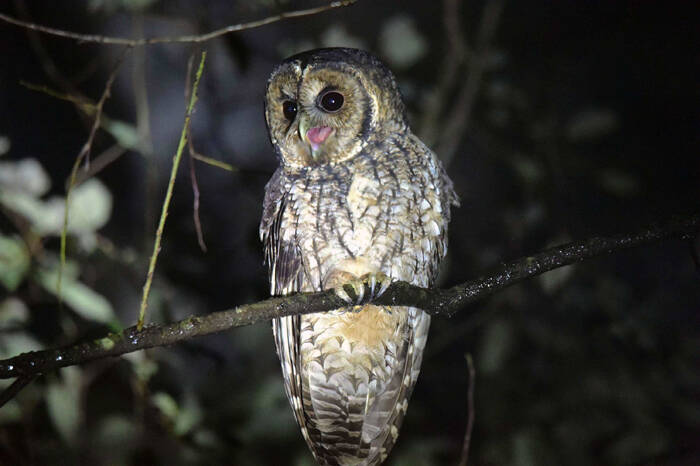Strix aluco
IUCN
LCBasic Information
Scientific classification
- name:Strix aluco
- Scientific Name:Strix aluco,Tawny Owl
- Outline:Raptor
- Family:Strigiformes Owl
Vital signs
- length:37-48cm
- Weight:322-909g
- lifetime:5-27years
Feature
The calls of male birds reflect their health and energy
Distribution and Habitat
The Tawny Owl is distributed in the southwest of Northeast China, northeastern Hebei, Shandong, Shaanxi, Hubei, Sichuan, southern Gansu, Guizhou, Yunnan, southern Tibet, Guangxi, Guangdong and Taiwan in China. Outside China, it is distributed in Europe, western Siberia, Central Asia, North Korea, India and northwestern Africa.
Tawny Owls mainly live in mountain broad-leaved forests and mixed forests, especially riverbanks and valley forests. They also appear in sparse forests and shrub areas at the edge of forests, preferring places near water sources. In cities, they live in cemeteries, gardens and parks. In colder areas, they are mainly distributed in lowlands, but they also breed in Scotland at an altitude of 550 meters, the Alps at 1,600 meters, Turkey at 2,350 meters and Myanmar at 2,800 meters.
Appearance
The gray forest owl has a round head, no ear feather clusters, a clear, orange-brown face, black feather tips with white feather shaft stripes, dark brown forehead, black top and back neck, and large orange-brown spots on the feather edges; the eyes reach up to the eyebrows The pattern is white with dark brown feather shaft lines and terminal spots, the wrinkled feathers are brown, and the ends of both turns have brown and white markings. The upper body is dark brown with orange-brown horizontal spots and spots, especially the upper back and shoulders are thicker. Most of the outer shoulder feathers are dark-yellow white, forming an obvious dark-yellow white shoulder spot. The upper wing coverts are dark brown with fine orange-brown spots. The middle coverts have large orange-brown subterminal spots. The subterminal spots of the large coverts are oval, brown or white. The primary coverts are dark brown with inconspicuous spots. Light brown horizontal spots and spots. The flight feather
Details
Tawny Owl, also known as Tawny Owl, is a medium-sized owl with 11 subspecies.

Tawny Owls often move in pairs or alone. It is nocturnal, hiding in dense forests during the day, perching motionlessly and upright on thick branches close to tree trunks with dense branches and leaves. It only comes out to move and hunt at dusk and at night, and sometimes comes out to move in the dark daytime and deep in the woods. It mainly feeds on rodents, but also eats small birds, frogs, small mammals and insects, and occasionally preys on fish in the water. In cities, the gray owl mainly preys on other birds. The main hunting method is to wait on the branches, and when the prey appears, it swoops down from a high place to catch the prey. The gray owl usually swallows the prey whole and spits out the indigestible parts, such as hair and bones, and uses them as nests under the tree. At night, the gray owl can catch smaller owls, but young gray owls may be hunted by eagle owls, goshawks or foxes. The gray owl can make a cooing sound. The calls of male birds reflect their health and energy: when they use less high frequencies, they show that they have a higher bloodworm load; if they use a more limited frequency, it means that they regard the other party as an intruder.
The breeding season of the gray forest owl is from January to April of the following year. It mainly nests in tree holes, sometimes on the ground under rocks or in crow nests. Each nest lays 1-8 eggs, usually 2-4. The size of the eggs is 46-49 mm × 39-42 mm. The female bird incubates the eggs, and the incubation period is 28-30 days. The chicks are altricial and can fly after 29-37 days of feeding by the parents. The chicks will leave the nest before they grow feathers. The survival rate of chicks is unknown, but the annual survival rate of adults is 76.8%. The average lifespan of the gray forest owl is about 5 years, but wild and captive gray forest owls have been found to be over 18 and 27 years old respectively.
The Tawny Owl has a wide distribution range and is not close to the vulnerable and endangered critical value standard for species survival (distribution area or fluctuation range less than 20,000 square kilometers, habitat quality, population size, and fragmented distribution area). The population trend is stable, so it is evaluated as a species of least concern.
On December 14, 2021, staff from the Jiuyishan National Nature Reserve Management Bureau in Hunan Province recently analyzed the data from 60 infrared cameras in the reserve and found 13 species of national key protected wild animals, including the first discovery of the national second-level protected animals, the Chinese Serow and the Gray Owl.
Listed in the 2014 Red List of Endangered Species of the World Conservation Union (IUCN) ver 3.1 - Least Concern (LC).
Listed in the "National Key Protected Wildlife List" issued by the Ministry of Forestry and the Ministry of Agriculture of China on January 14, 1989 as a Class II protected animal.
Protect wild animals and stop eating game.
Maintaining ecological balance is everyone's responsibility!








